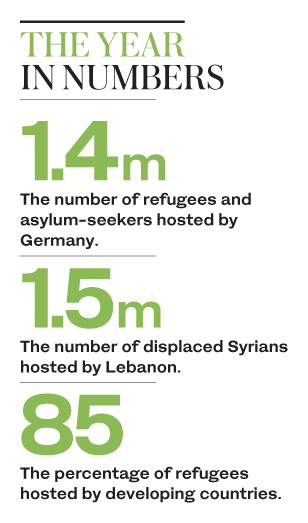ABU DHABI: The untold story of migration in 2018 is the positive and proactive treatment by countries that host the largest refugee populations in the world.
As of May, more than 65 million forcibly displaced people had been recorded worldwide, of whom 25.4 million were refugees. Of the countries classified as high income, Germany is the most generous host, with 669,500 displaced people, according to the latest report by the UN High Commissioner for Refugees (UNHCR).
But it might surprise many that 85 percent of refugees are hosted by developing countries, with Pakistan, Uganda and Turkey topping the list.
On the one hand, the number of refugees worldwide touched a new high this year, and populist political parties made unprecedented gains in elections in Western countries, using anti-immigrant rhetoric.
On the other, the global refugee situation in 2018 saw a number of developments that bode well for the future of displaced populations.
These include regional response plans, follow-up to the 2016 New York Declaration for Refugees and Migrants, and the agreement on the UN-led Global Compact for Safe, Orderly and Regular Migration reached in Marrakech this month.
Overall, 2018 has been notable for innovative approaches to displaced populations, localized aid provision, and focused “whole-of-society” projects spearheaded by the UNHCR.
 The fact that more than half the world’s refugees and asylum-seekers are young people does not mean that they will join the ranks of the uneducated and unemployable.
The fact that more than half the world’s refugees and asylum-seekers are young people does not mean that they will join the ranks of the uneducated and unemployable.
Improvements in addressing displacement have had a positive impact on new and budding educational initiatives, and opened up alternative pathways for refugee children to obtain degrees.
A survey conducted by the Pew Research Center in Europe has revealed a contrast between people’s attitudes toward refugees inside the EU, and criticism directed at institutional handling of the new arrivals. Hosting more than 1.4 million refugees and asylum-seekers, Germany has made the most progress this year.
The Interior Ministry conducted an internal review of asylum cases handled in the first quarter of the year, which showed that 99 percent of the decisions were correct.
In addition, 2018 saw more than 300,000 refugees in Germany gaining some form of employment, and about 28,000 completing various apprenticeships by May.
The key to their success was their new German-language skills, according to the German Labor Office. As of July, nearly 500,000 refugees had been registered as “looking for work” by the office.
Situated on two continents, Turkey hosts almost 4 million refugees, with displaced Syrians constituting the vast majority.
Of the 1 million Syrians between the ages of 15 and 24, more than 20,000 have been enrolled in schools this year via the municipality-based approach of the Turkish authorities.
Social services include free language courses, expanding participation in formal education, provision of medical care and flexibility in opening businesses. More than 6,500 companies have been set up by Syrians since 2011, culminating in an explosion of refugee entrepreneurship in 2018.
 Pakistan is home to more than 2.7 million Afghan refugees, 60 percent of whom were born in the host country, many having fled the Soviet invasion of 1979. In the first quarter of 2018, more than 14,000 displaced children were registered with Pakistan’s government and the UNHCR; more than 11,000 received birth certificates.
Pakistan is home to more than 2.7 million Afghan refugees, 60 percent of whom were born in the host country, many having fled the Soviet invasion of 1979. In the first quarter of 2018, more than 14,000 displaced children were registered with Pakistan’s government and the UNHCR; more than 11,000 received birth certificates.
Uganda hosts more than 1.5 million refugees, making it Africa’s largest host. The country recorded more than 9,000 arrivals — South Sudanese, Congolese and Burundians — in August alone. Despite the strain on its capacity for assistance, Uganda has continued implementing its 2019-2020 Refugee Response Plan, which includes running an Ebola preparedness program and a verification scheme that has handled 874,530 people since the start of 2018.
The verification exercise includes smart technology that generates data with a high level of accuracy.
Supported by the World Bank, Uganda has also launched a national program to strengthen secondary education capacities and improve the livelihood of refugees.
As an example of its long-term commitment to helping refugees, the title of “best school” in the country this year went to one started by Congolese refugees. The school has been sending students to top universities worldwide.
On June 20, World Refugee Day, the Dubai-based Abdul Aziz Al Ghurair Foundation for Education launched the Refugee Education Fund for refugee youths in Jordan and Lebanon, and for Arab children residing in the UAE who have been affected by wars and disasters. The three-year program is expected to benefit more than 5,000 children.
As of June, the UNHCR in Jordan provided comprehensive primary, secondary and tertiary education, as well as free medical services to vulnerable Syrians and non-Syrians in urban areas. In February, the UNHCR and the International Labour Organization (ILO) inaugurated in Jordan the second employment office ever in a refugee camp.
Neighboring Lebanon is home to more than 1.5 million displaced Syrians, the highest per-capita number of refugees in the world. With children and youths accounting for half of displaced Syrians in the country, the government has reaffirmed its commitment to the 2017-2020 Lebanon Crisis Response Plan and a multi-stakeholder approach to refugees.
These collective efforts to increase the resilience of displaced populations have marked 2018 despite massive gaps in funding.
Given that international private investment tends to flow in the direction of innovation, the focus this year has been on applying technology to education by introducing online degrees and more evidence-based data collection on displaced populations.
The coming year has the potential to be a game-changer for displaced populations in at least three ways.
Firstly, as a follow-up to the 2016 New York Declaration for Refugees and Migrants, the Global Compact may well set the tone for a new approach to forced migration.
The UN-led pact is founded on the conclusion that no state can successfully address migration alone. This show of solidarity has sent the message that multilateralism in refugee assistance is strong and full of promise.
Secondly, former refugees’ success in winning elections or popular support, and holding public office, shows the long-term benefits of proper refugee assistance. Next year will no doubt be marked by more refugee success stories, such as the one of Ilhan Omar, who was elected to the US Congress in November.
Thirdly, 2019 is likely to witness the emergence of new actors in refugee assistance. As a regional example of innovation in refugee assistance, Saudi Arabia has granted access to public education and medical care for displaced Syrians residing in the Kingdom.
The UN’s Comprehensive Refugee Response Framework and new actors in the field have brightened the prospects of alternative approaches to asylum and refuge in the coming year.
Last but not least, 2019 could see the birth of a blueprint for the future of displacement. This could restore the credibility of internally displaced persons (IDPs), release pressures on governments, provide more data to reduce security threats, and help the planet’s most vulnerable group of people envision a brighter future.
- EmIna Osmandzikovic is a researcher at TRENDS Research & Advisory.













